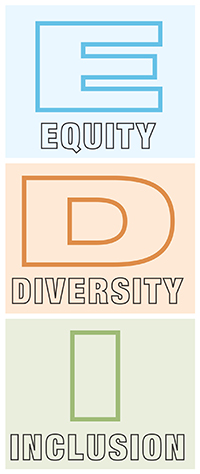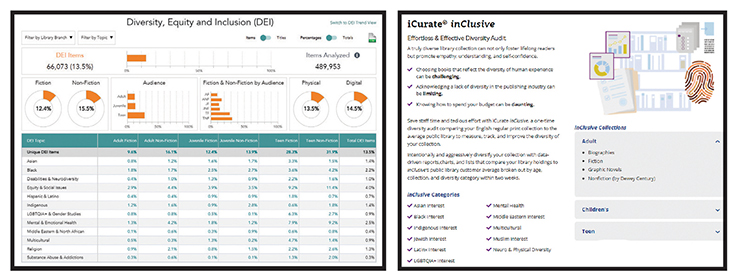DEI Audits: The Whole Picture | Equity
How diversity, equity, and inclusion auditing tools help build stronger collections.
 How diversity, equity, and inclusion auditing tools help build stronger collections
How diversity, equity, and inclusion auditing tools help build stronger collections
Last year, I received a fortune cookie from a library friend. The fortune inside read “a diversity audit is in your future.” Of course, the fortune was written and planted by my friend as a wink and a nod to the hard work and complexity of the diversity auditing process, but for many of us who are committed to building strong collections developed through a diversity, equity, and inclusion (DEI) lens, that fortune may very well be true.
Diversity auditing isn’t easy. It’s often painfully slow and high touch, and must be conducted with care. This process of discovering, acknowledging, and (hopefully) mitigating collection gaps can be akin to finding and placing a missing puzzle piece, as it allows patrons to benefit from a collection that reflects a more complete picture.
In response to the collective need for libraries to more easily analyze the diversity of their collections at the item level, Baker & Taylor, Ingram, and OverDrive have recently introduced collection development auditing tools. But, it is important to note that these tools—Collection HQ’s Diversity, Equity and Inclusion Analysis, iCurate inClusive, and OverDrive’s diversity auditing support services—were not designed to replace the manual diversity auditing process, but to enhance it. In other words, you’re still the leading actor in the diversity auditing process, with these tools acting in a supporting role.
HOW DO THESE TOOLS WORK?
It is easier for me to determine whether a resource is beneficial when I understand how it works. If you’re familiar with the dashboard formats used by Ingram and Baker & Taylor to support the collection development process, then you’ll easily be able to navigate iCurate inClusive and Collection HQ’s DEI-focused collection auditing tools. Earlier I mentioned how painfully slow the diversity auditing process could be. In these tools, users get back some of the time lost, as both platforms quickly and responsively provide a snapshot of the diversity gaps in collections.
OverDrive’s strategy to support DEI-focused collection auditing is decidedly more hands-on. In order to evaluate a collection for diverse titles, a library requests a diversity audit from its Overdrive Account Manager. From there, OverDrive’s Content Specialist and Staff Librarians develop and present a live, customized report to the library. Post-presentation, OverDrive works with the library to develop an individualized set of collections goals based on the findings.
What sets OverDrive’s resource apart from iCurate inClusive and Collection HQ is that it doesn’t provide a tech-based interface to support collection development. This nuanced, multi-stepped approach to DEI-focused collection auditing support would particularly benefit libraries without the staff bandwidth to support more in-depth diversity audits. However, will this resource benefit a library looking for immediate access to specific information?
EXPANSIVE DEI SEARCH CATEGORIES
When it comes to specific information, these DEI tools deliver by offering expansive search categories. While both iCurate inClusive and Collection HQ have similar scope, iCurate inClusive, offering twelve DEI search categories, has built in additional categories for Muslim and Jewish Interest that focus on both cultural and religious aspects. Similarly, Collection HQ, with thirteen DEI search categories, has developed specialized categories that include Equity and Social Issues, Religion, and Substance Abuse.
OverDrive’s hand-curated lists have been developed for eight categories, in addition to lists dedicated to diverse book awards, and specialized list categories based on interest.
Each of the librarians I spoke with about these DEI collection auditing tools found the categories provided to be extremely broad. So broad, in fact, that some wondered if, in its vastness, something important could be easily overlooked. Of course, as we’re in the early days of utilizing these tools, there’s still opportunity to expand or narrow search categories. OverDrive’s current list of categories are a mix of backlist and frontlist content, classics, authors, and characters. Future iterations of OverDrive’s DEI collection auditing resource could see lists categorized in a way that makes it easier to view offerings from authors who are members of diverse populations, apart from titles that may not fit into that category.
 |
AUDIT ASSISTANCE Baker & Taylor’s Collection HQ (left) and Ingram’s iCurate inClusive (right) help supplement manual audits |
BIPOC LIVED EXPERIENCES
One of the most important considerations for these DEI auditing tools are the ways in which they approach, amplify, and acknowledge BIPOC (Black, Indigenous, people of color) lived experiences. In conducting the diversity auditing process, it’s important to check our own biases, particularly as we must acknowledge that bias is often an uninvited guest. That is the humanness of bias. If we’re able to see bias in ourselves, we must also consider how bias could also show up in the technology we use to evaluate our collections. There’s no denying technology’s impact on the ways in which we search for, categorize, and evaluate books. This is why it is so important that Collection HQ’s Diversity, Equity and Inclusion Analysis, iCurate inClusive, and OverDrive’s diversity auditing support services make it a practice to thoughtfully identify keywords, and effectively manipulate Library of Congress and BISAC headings to better find books. At one of the libraries helping to shape Collection HQ’s DEI tool, Carol Green, collections services manager at Chattanooga Public Library, realized this early on in the development process. “One of the first thoughts I had was how the DEI tool was going to find these [diverse] books if the catalog didn’t have these specific keywords,” she shares.
For Green, the importance of accurately and effectively identifying keywords was underscored when she noticed that author Amy Tan, who is Chinese American, was not properly categorized. Green shared her concerns with Collection HQ, and, in response, the team developed a process to allow users to manually add titles.
Another important aspect to consider is how these tools ensure that the titles included do not feature stereotypes or tropes. “I do wonder if these tools are folding in socioeconomic status inside of equity and social issues,” shares Dontaná McPherson-Joseph, Collection Development Librarian at Illinois’s Oak Park Public Library. “I would be interested to see how that would be teased out. If all of the stories returned about anyone who is not white include narratives that they are poor, or urban, or in prison, it’s really doing a disservice to the tool, a disservice to users, and I would be interested to see if they could pull that out.”
When we think of DEI in library services we often ask: Who is being seen, who isn’t being seen, and why? The diversity auditing process invites us to ask new questions—Who isn’t being considered? Why can’t I find these stories in our collection? Whose interests, perspectives, stories, histories are being overlooked?
ARE THESE TOOLS RIGHT FOR MY ORGANIZATION?
During my research on these tools, I spoke with someone who asked “why are we tracking this data, other than our edification?” If your library has been successfully implementing collection development measures that embody the windows and mirrors approach, you may feel that utilizing these resources is of no benefit. But as library workers, we’re in the information business, and when it comes to identifying ways in which we can better serve often marginalized populations, it’s always better to take a “more is more” approach.
And while I realize that the size and scope of each library is vastly different, and the case utilization for these tools may vary, it’s difficult to imagine a library that would not benefit from CollectionHQ’s branch, system, or regional level–DEI analysis capabilities, iCurate inClusive’s comprehensive presentation feature, or OverDrive’s concierge-level diversity auditing resources.
Ultimately, I am not here to sell these products, or extol their value. I’m here to share what I’ve learned about them based on interviews and analysis. And, based on what I’ve learned from the many librarians I’ve spoken with about these tools, they view the idea of having access to a snapshot of their collections as a win, understanding that these tools are exactly that—tools that cannot and do not replace the diversity audit itself. If your library is committed to a holistic approach to DEI work, that work must start at the heart of library services—our collections. These tools, in concert with the diversity audit, allow us to keep our promise that libraries are for everyone, because they allow us to build strong collections that don’t overlook anyone.
For more resources and information on conducting a diversity audit, check out “Diversity Auditing 101: How to Evaluate Your Collection” by Karen Jensen.
Christina Fuller-Gregory (she/her/hers) is a librarian, maker, and experienced equity, diversity, inclusion, and social justice practitioner. A 2021 Library Journal Mover and Shaker, Christina’s work is driven by a desire to see libraries develop strategies for weaving equity, diversity, and inclusion into the fabric of their organizations.
RELATED
ALREADY A SUBSCRIBER? LOG IN
We are currently offering this content for free. Sign up now to activate your personal profile, where you can save articles for future viewing









Add Comment :-
Comment Policy:
Comment should not be empty !!!